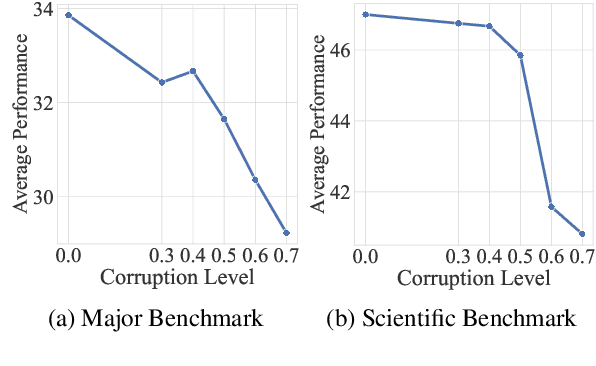Ruihua Song
MARS: Optimizing Dual-System Deep Research via Multi-Agent Reinforcement Learning
Oct 06, 2025Abstract:Large Reasoning Models (LRMs) often exhibit a tendency for overanalysis in simple tasks, where the models excessively utilize System 2-type, deliberate reasoning, leading to inefficient token generation. Furthermore, these models face challenges in adapting their reasoning capabilities to rapidly changing environments due to the static nature of their pretraining data. To address these issues, advancing Large Language Models (LLMs) for complex reasoning tasks requires innovative approaches that bridge intuitive and deliberate cognitive processes, akin to human cognition's dual-system dynamic. This paper introduces a Multi-Agent System for Deep ReSearch (MARS) enabling seamless integration of System 1's fast, intuitive thinking with System 2's deliberate reasoning within LLMs. MARS strategically integrates multiple external tools, such as Google Search, Google Scholar, and Python Interpreter, to access up-to-date information and execute complex computations, while creating a specialized division of labor where System 1 efficiently processes and summarizes high-volume external information, providing distilled insights that expand System 2's reasoning context without overwhelming its capacity. Furthermore, we propose a multi-agent reinforcement learning framework extending Group Relative Policy Optimization to simultaneously optimize both systems with multi-turn tool interactions, bin-packing optimization, and sample balancing strategies that enhance collaborative efficiency. Extensive experiments demonstrate MARS achieves substantial improvements of 3.86% on the challenging Humanity's Last Exam (HLE) benchmark and an average gain of 8.9% across 7 knowledge-intensive tasks, validating the effectiveness of our dual-system paradigm for complex reasoning in dynamic information environments.
Select, Read, and Write: A Multi-Agent Framework of Full-Text-based Related Work Generation
May 26, 2025Abstract:Automatic related work generation (RWG) can save people's time and effort when writing a draft of related work section (RWS) for further revision. However, existing methods for RWG always suffer from shallow comprehension due to taking the limited portions of references papers as input and isolated explanation for each reference due to ineffective capturing the relationships among them. To address these issues, we focus on full-text-based RWG task and propose a novel multi-agent framework. Our framework consists of three agents: a selector that decides which section of the papers is going to read next, a reader that digests the selected section and updates a shared working memory, and a writer that generates RWS based on the final curated memory. To better capture the relationships among references, we also propose two graph-aware strategies for selector, enabling to optimize the reading order with constrains of the graph structure. Extensive experiments demonstrate that our framework consistently improves performance across three base models and various input configurations. The graph-aware selectors outperform alternative selectors, achieving state-of-the-art results. The code and data are available at https://github.com/1190200817/Full_Text_RWG.
Evaluating Text Creativity across Diverse Domains: A Dataset and Large Language Model Evaluator
May 25, 2025Abstract:Creativity evaluation remains a challenging frontier for large language models (LLMs). Current evaluations heavily rely on inefficient and costly human judgments, hindering progress in enhancing machine creativity. While automated methods exist, ranging from psychological testing to heuristic- or prompting-based approaches, they often lack generalizability or alignment with human judgment. To address these issues, in this paper, we propose a novel pairwise-comparison framework for assessing textual creativity, leveraging shared contextual instructions to improve evaluation consistency. We introduce CreataSet, a large-scale dataset with 100K+ human-level and 1M+ synthetic creative instruction-response pairs spanning diverse open-domain tasks. Through training on CreataSet, we develop an LLM-based evaluator named CrEval. CrEval demonstrates remarkable superiority over existing methods in alignment with human judgments. Experimental results underscore the indispensable significance of integrating both human-generated and synthetic data in training highly robust evaluators, and showcase the practical utility of CrEval in boosting the creativity of LLMs. We will release all data, code, and models publicly soon to support further research.
Think Silently, Think Fast: Dynamic Latent Compression of LLM Reasoning Chains
May 22, 2025



Abstract:Large Language Models (LLMs) achieve superior performance through Chain-of-Thought (CoT) reasoning, but these token-level reasoning chains are computationally expensive and inefficient. In this paper, we introduce Compressed Latent Reasoning (CoLaR), a novel framework that dynamically compresses reasoning processes in latent space through a two-stage training approach. First, during supervised fine-tuning, CoLaR extends beyond next-token prediction by incorporating an auxiliary next compressed embedding prediction objective. This process merges embeddings of consecutive tokens using a compression factor randomly sampled from a predefined range, and trains a specialized latent head to predict distributions of subsequent compressed embeddings. Second, we enhance CoLaR through reinforcement learning (RL) that leverages the latent head's non-deterministic nature to explore diverse reasoning paths and exploit more compact ones. This approach enables CoLaR to: i) perform reasoning at a dense latent level (i.e., silently), substantially reducing reasoning chain length, and ii) dynamically adjust reasoning speed at inference time by simply prompting the desired compression factor. Extensive experiments across four mathematical reasoning datasets demonstrate that CoLaR achieves 14.1% higher accuracy than latent-based baseline methods at comparable compression ratios, and reduces reasoning chain length by 53.3% with only 4.8% performance degradation compared to explicit CoT method. Moreover, when applied to more challenging mathematical reasoning tasks, our RL-enhanced CoLaR demonstrates performance gains of up to 5.4% while dramatically reducing latent reasoning chain length by 82.8%. The code and models will be released upon acceptance.
Enhancing Audiovisual Speech Recognition through Bifocal Preference Optimization
Dec 26, 2024



Abstract:Audiovisual Automatic Speech Recognition (AV-ASR) aims to improve speech recognition accuracy by leveraging visual signals. It is particularly challenging in unconstrained real-world scenarios across various domains due to noisy acoustic environments, spontaneous speech, and the uncertain use of visual information. Most previous works fine-tune audio-only ASR models on audiovisual datasets, optimizing them for conventional ASR objectives. However, they often neglect visual features and common errors in unconstrained video scenarios. In this paper, we propose using a preference optimization strategy to improve speech recognition accuracy for real-world videos. First, we create preference data via simulating common errors that occurred in AV-ASR from two focals: manipulating the audio or vision input and rewriting the output transcript. Second, we propose BPO-AVASR, a Bifocal Preference Optimization method to improve AV-ASR models by leveraging both input-side and output-side preference. Extensive experiments demonstrate that our approach significantly improves speech recognition accuracy across various domains, outperforming previous state-of-the-art models on real-world video speech recognition.
Two-in-One: Unified Multi-Person Interactive Motion Generation by Latent Diffusion Transformer
Dec 21, 2024



Abstract:Multi-person interactive motion generation, a critical yet under-explored domain in computer character animation, poses significant challenges such as intricate modeling of inter-human interactions beyond individual motions and generating two motions with huge differences from one text condition. Current research often employs separate module branches for individual motions, leading to a loss of interaction information and increased computational demands. To address these challenges, we propose a novel, unified approach that models multi-person motions and their interactions within a single latent space. Our approach streamlines the process by treating interactive motions as an integrated data point, utilizing a Variational AutoEncoder (VAE) for compression into a unified latent space, and performing a diffusion process within this space, guided by the natural language conditions. Experimental results demonstrate our method's superiority over existing approaches in generation quality, performing text condition in particular when motions have significant asymmetry, and accelerating the generation efficiency while preserving high quality.
BSharedRAG: Backbone Shared Retrieval-Augmented Generation for the E-commerce Domain
Sep 30, 2024



Abstract:Retrieval Augmented Generation (RAG) system is important in domains such as e-commerce, which has many long-tail entities and frequently updated information. Most existing works adopt separate modules for retrieval and generation, which may be suboptimal since the retrieval task and the generation task cannot benefit from each other to improve performance. We propose a novel Backbone Shared RAG framework (BSharedRAG). It first uses a domain-specific corpus to continually pre-train a base model as a domain-specific backbone model and then trains two plug-and-play Low-Rank Adaptation (LoRA) modules based on the shared backbone to minimize retrieval and generation losses respectively. Experimental results indicate that our proposed BSharedRAG outperforms baseline models by 5% and 13% in Hit@3 upon two datasets in retrieval evaluation and by 23% in terms of BLEU-3 in generation evaluation. Our codes, models, and dataset are available at https://bsharedrag.github.io.
ESPnet-Codec: Comprehensive Training and Evaluation of Neural Codecs for Audio, Music, and Speech
Sep 24, 2024Abstract:Neural codecs have become crucial to recent speech and audio generation research. In addition to signal compression capabilities, discrete codecs have also been found to enhance downstream training efficiency and compatibility with autoregressive language models. However, as extensive downstream applications are investigated, challenges have arisen in ensuring fair comparisons across diverse applications. To address these issues, we present a new open-source platform ESPnet-Codec, which is built on ESPnet and focuses on neural codec training and evaluation. ESPnet-Codec offers various recipes in audio, music, and speech for training and evaluation using several widely adopted codec models. Together with ESPnet-Codec, we present VERSA, a standalone evaluation toolkit, which provides a comprehensive evaluation of codec performance over 20 audio evaluation metrics. Notably, we demonstrate that ESPnet-Codec can be integrated into six ESPnet tasks, supporting diverse applications.
See or Guess: Counterfactually Regularized Image Captioning
Aug 29, 2024



Abstract:Image captioning, which generates natural language descriptions of the visual information in an image, is a crucial task in vision-language research. Previous models have typically addressed this task by aligning the generative capabilities of machines with human intelligence through statistical fitting of existing datasets. While effective for normal images, they may struggle to accurately describe those where certain parts of the image are obscured or edited, unlike humans who excel in such cases. These weaknesses they exhibit, including hallucinations and limited interpretability, often hinder performance in scenarios with shifted association patterns. In this paper, we present a generic image captioning framework that employs causal inference to make existing models more capable of interventional tasks, and counterfactually explainable. Our approach includes two variants leveraging either total effect or natural direct effect. Integrating them into the training process enables models to handle counterfactual scenarios, increasing their generalizability. Extensive experiments on various datasets show that our method effectively reduces hallucinations and improves the model's faithfulness to images, demonstrating high portability across both small-scale and large-scale image-to-text models. The code is available at https://github.com/Aman-4-Real/See-or-Guess.
Towards Effective and Efficient Continual Pre-training of Large Language Models
Jul 26, 2024



Abstract:Continual pre-training (CPT) has been an important approach for adapting language models to specific domains or tasks. To make the CPT approach more traceable, this paper presents a technical report for continually pre-training Llama-3 (8B), which significantly enhances the Chinese language ability and scientific reasoning ability of the backbone model. To enhance the new abilities while retaining the original abilities, we design specific data mixture and curriculum strategies by utilizing existing datasets and synthesizing high-quality datasets. Specifically, we synthesize multidisciplinary scientific question and answer (QA) pairs based on related web pages, and subsequently incorporate these synthetic data to improve the scientific reasoning ability of Llama-3. We refer to the model after CPT as Llama-3-SynE (Synthetic data Enhanced Llama-3). We also present the tuning experiments with a relatively small model -- TinyLlama, and employ the derived findings to train the backbone model. Extensive experiments on a number of evaluation benchmarks show that our approach can largely improve the performance of the backbone models, including both the general abilities (+8.81 on C-Eval and +6.31 on CMMLU) and the scientific reasoning abilities (+12.00 on MATH and +4.13 on SciEval), without hurting the original capacities. Our model, data, and codes are available at https://github.com/RUC-GSAI/Llama-3-SynE.
 Add to Chrome
Add to Chrome Add to Firefox
Add to Firefox Add to Edge
Add to Edge